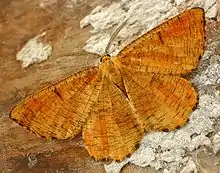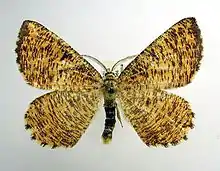Angerona prunaria
Angerona is a monotypic moth genus in the family Geometridae erected by Philogène Auguste Joseph Duponchel in 1829. Its only species, Angerona prunaria, the orange moth, was first described by Carl Linnaeus in his 1758 10th edition of Systema Naturae.[1]
| Orange moth | |
|---|---|
 | |
 | |
| Mounted | |
| Scientific classification | |
| Kingdom: | |
| Phylum: | |
| Class: | |
| Order: | |
| Family: | |
| Genus: | Angerona Duponchel, 1829 |
| Species: | A. prunaria |
| Binomial name | |
| Angerona prunaria | |
Description
Angerona prunaria is a relatively large and prominent representatives of the geometer moths. It can reach a wingspan of 35–45 mm, rarely up to 56 mm. As in most Lepidoptera, the males are usually slightly smaller than the females.
The ground colour is red to orange or yellow. There is a fine grey to almost black cross stippling and a transverse vein spot in females. The fringes have dark spots. The species is very variable. The males of this species are brighter in colour than the females, both sexes can be found in the typical plain orange form, as well as f. corylaria, which exhibits an orange band on a dark brown ground colour.
The moth prefers forest areas and is found in central and northern Europe, Russia and the Middle East.
The flight time is May to July.
The larva feeds on Prunus spinosa, Lonicera xylosteum , Populus tremula, Frangula dodonei and Vaccinium myrtillus.

 Form corylaria
Form corylaria
References
- Savela, Markku. "Angerona Duponchel, 1829". Lepidoptera and Some Other Life Forms. Retrieved February 2, 2019.
External links
| Wikimedia Commons has media related to Angerona prunaria. |
- "70.230 BF1924 Orange Moth Angerona prunaria (Linnaeus, 1758)". UKMoths. Retrieved 2 February 2019.
- "07665 Angerona prunaria (Linnaeus, 1758) - Schlehenspanner". Lepiforum e.V. Retrieved 2 February 2019.